How To Put Last Name And Page Number On Word 2013
Lesson 17: Headers, Footers, and Page Numbers
/en/word2013/columns/content/
Introduction
The header is a section of the document that appears in the top margin, while the footer is a section of the document that appears in the bottom margin. Headers and footers generally contain additional data such as page numbers, dates, an author's proper noun, and footnotes, which tin can help continue longer documents organized and make them easier to read. Text entered in the header or footer will appear on each page of the document.
Optional: Download our practice document.
To create a header or footer:
In our instance, we want to display the author'due south proper noun at the top of each page, so we'll place it in the header.
- Double-click anywhere on the height or bottom margin of your document. In our example, we'll double-click the summit margin.
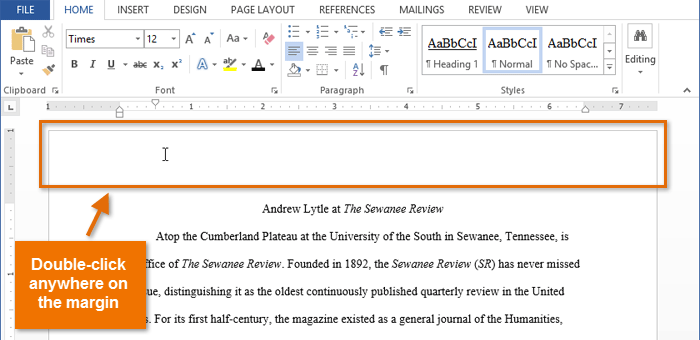 Double-clicking on the header
Double-clicking on the header - The header or footer volition open up, and a Design tab volition appear on the right side of the Ribbon. The insertion point will appear in the header or footer.
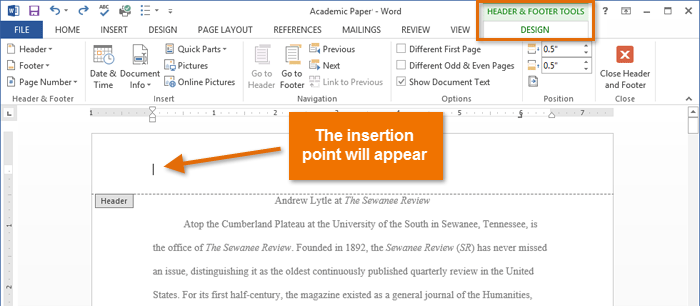 The open header
The open header - Type the desired information into the header or footer. In our example, we'll type the writer'due south name.
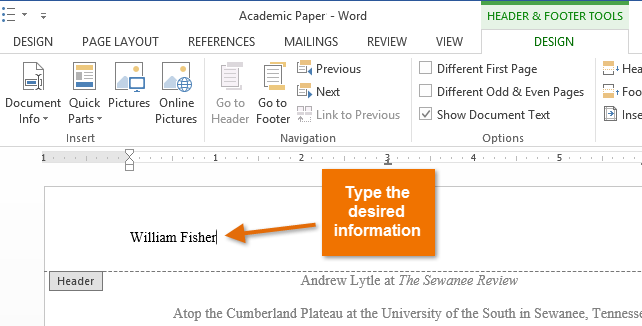 Typing text into a header
Typing text into a header - When you're finished, click Close Header and Footer. Alternatively, yous tin can press the Esc key.
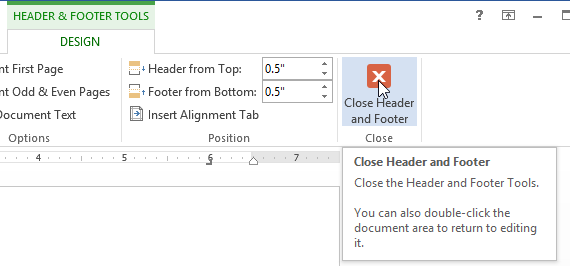 Clicking Close Header and Footer
Clicking Close Header and Footer - The header or footer text will announced.
 The finished header
The finished header
To insert a preset header or footer:
Discussion has a diverseness of preset headers and footers you can utilise to enhance your document's design and layout. In our example, we'll add a preset header to our document.
- Select the Insert tab, and then click the Header or Footer command. In our example, we'll click the Header command.
 Clicking the Header command
Clicking the Header command - In the menu that appears, select the desired preset header or footer. In our example, we'll select a header.
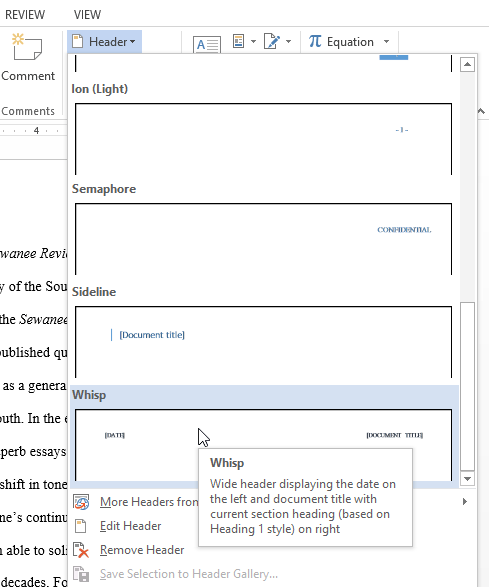 Selecting a preset header
Selecting a preset header - The header or footer will announced. Preset headers and footers contain placeholders for data such as the title or appointment; they are known as Content Control fields.
 Content Command fields
Content Command fields - To edit a Content Command field, click it and type the desired data.
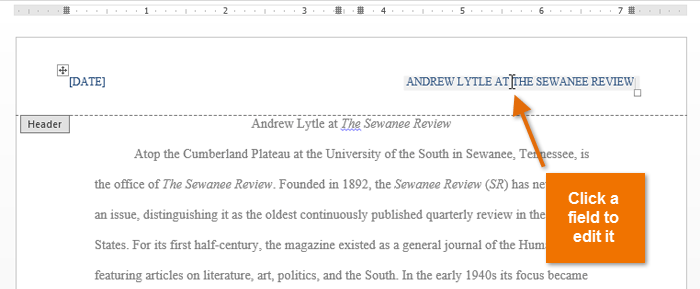 Editing a Content Control field
Editing a Content Control field - When you're finished, click Close Header and Footer. Alternatively, you tin can printing the Esc central.
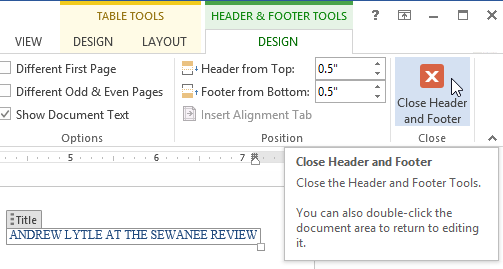 Endmost the Header and Footer
Endmost the Header and Footer
If you want to delete a Content Control field, right-click it and select Remove Content Control from the menu that appears.
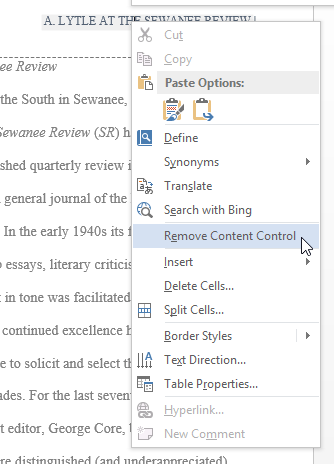 Removing a Content Control field
Removing a Content Control field
Editing headers and footers
Afterward you close the header or footer, information technology will still exist visible, but it will be locked. Simply double-click a header or footer to unlock information technology, which will allow you to edit information technology.
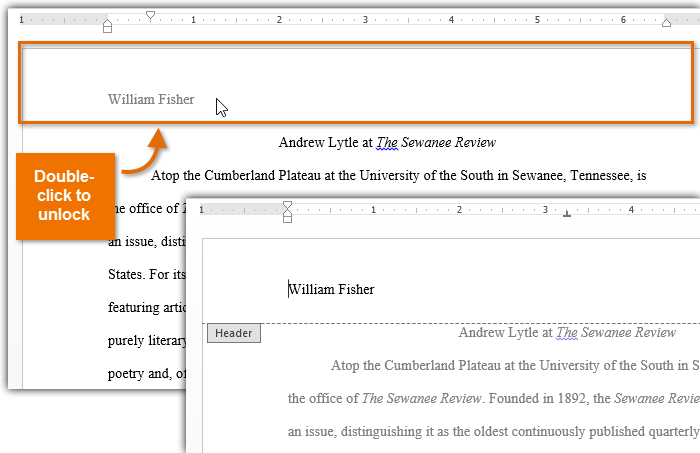 Opening a header
Opening a header
Design tab options
When your certificate's header and footer are unlocked, the Blueprint tab will appear on the right side of the Ribbon, giving you various editing options:
- Hibernate the kickoff-page header and footer: For some documents, you may non want the first page to show the header and footer, like if you accept a comprehend page and want to start the folio numbering on the second page. If you desire to hide the offset folio header and footer, bank check the box next to Different Beginning Page.
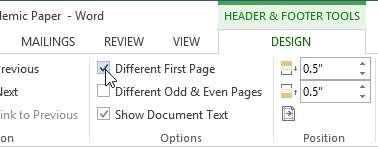 Hiding the first page header and footer
Hiding the first page header and footer - Remove the header: If y'all want to remove all information contained in the header, click the Header control and select Remove Header from the menu that appears.
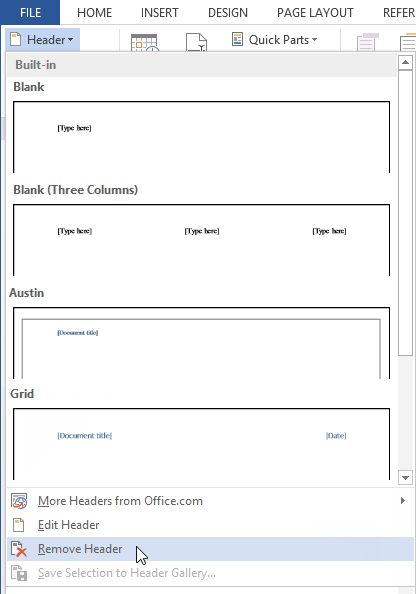 Removing the header
Removing the header
- Remove the footer: If you desire to remove all information contained in the footer, click the Footer command and select Remove Footer from the carte du jour that appears.
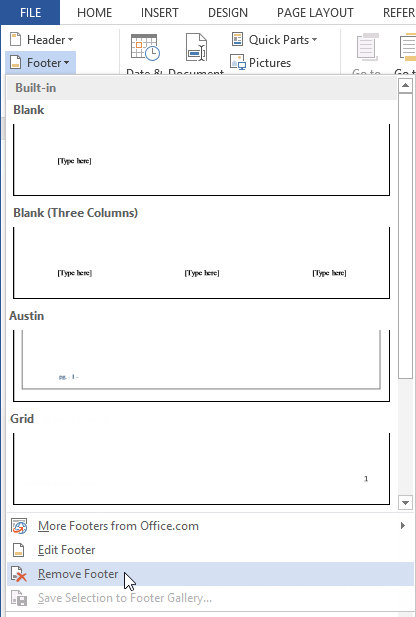 Removing the footer
Removing the footer
- Additional options: With the Page Number command and the commands available in the Insert grouping, you can add page numbers, the date and time, pictures, and more to your header or footer.
 Insert grouping on the Ribbon
Insert grouping on the Ribbon
To insert the engagement or time into a header or footer:
Sometimes it'southward helpful to include the date or fourth dimension in the header or footer. For instance, you may want your document to evidence the date when information technology was created.
On the other manus, yous may want to show the date when it was printed, which you can practise by setting it to update automatically. This is useful if you frequently update and impress a document because you'll always be able to tell which version is the most recent.
- Double-click anywhere on the header or footer to unlock it. Place the insertion point where you want the date or time to appear. In our example, nosotros'll place the insertion point on the line below the author'south name.
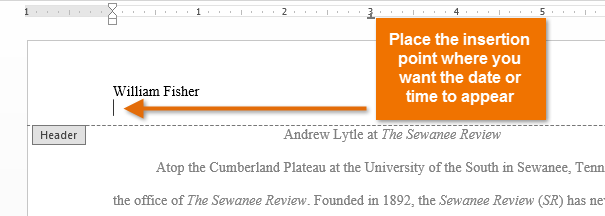 Placing the insertion indicate in the unlocked header
Placing the insertion indicate in the unlocked header - The Design tab will appear. Click the Engagement & Time command.
 Clicking the Date & Time command
Clicking the Date & Time command - The Engagement and Time dialog box will announced. Select the desired date or time format.
- Bank check the box next to Update Automatically if you want the date to change every time you open up the document. If you lot don't want the date to change, leave this choice unchecked.
- Click OK.
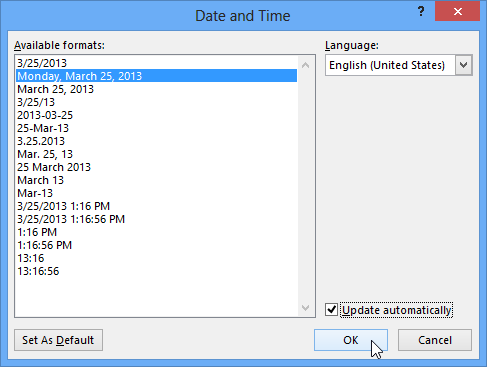 Selecting a date option
Selecting a date option - The date will appear in the header.
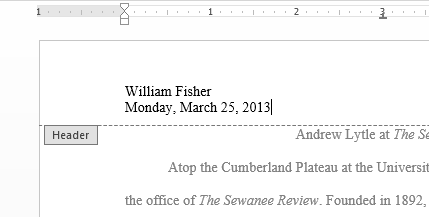 The appointment in the header
The appointment in the header
Adding page numbers
Give-and-take can automatically label each page with a folio number and place it in a header, footer, or side margin. When you need to number some pages differently, Discussion allows you to restart page numbering.
To add folio numbers to a document:
In our instance, nosotros'll add folio numbering to our document's footer.
- Double-click anywhere on the header or footer to unlock it. If you don't already have a header or footer, yous tin can double-click well-nigh the peak or bottom of the page. The Blueprint tab will announced on the right side of the Ribbon.
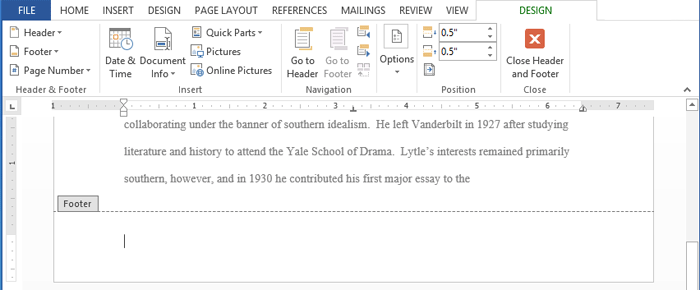 Unlocking the footer
Unlocking the footer - Click the Page Number command. In the carte du jour that appears, hover the mouse over Current Position and select the desired page numbering manner.
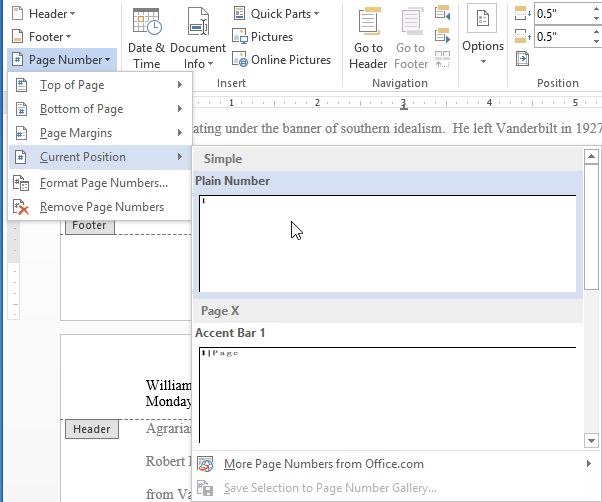 Selecting a page number fashion
Selecting a page number fashion - Page numbering volition appear.
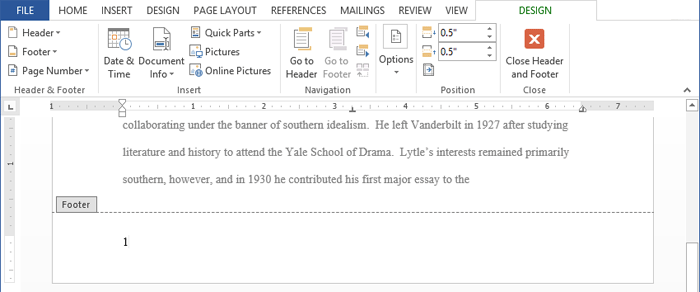 A page number in the footer
A page number in the footer - To edit the font, font size, and alignment of page numbers, select a page number and click the Home tab. Give-and-take'south text formatting options will appear.
 Clicking the Home tab
Clicking the Home tab - When you're finished, printing the Esc fundamental. The page numbering will be formatted.
 A formatted page number
A formatted page number
Alternatively, you can add folio numbers to the header or footer by clicking the Page Number command so selecting Top of Page or Bottom of Page. If y'all have an existing header or footer, it will be removed and replaced with the folio number.
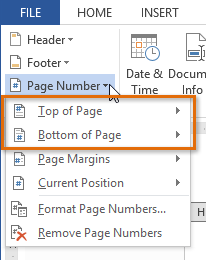 Superlative of Page and Bottom of Page options
Superlative of Page and Bottom of Page options
To restart page numbering:
Discussion allows y'all to restart page numbering on any folio of your document. You tin can do this by inserting a section interruption and then selecting the number you desire to restart the numbering with. In our example, we'll restart the page numbering for our document's Works Cited department.
- Identify the insertion signal at the top of the folio you want to restart folio numbering for. If at that place is text on the page, identify the insertion point at the start of the text.
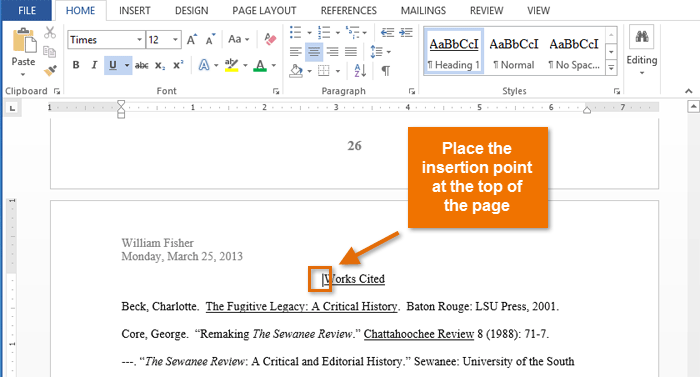 Placing the insertion bespeak
Placing the insertion bespeak - Select the Page Layout tab, and then click the Breaks command. Select Next Page from the drop-down bill of fare that appears.
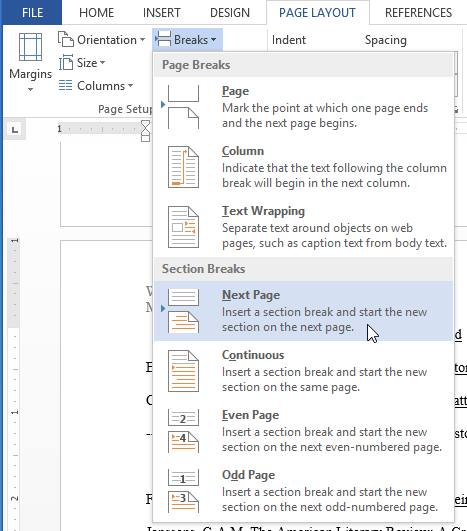 Selecting Adjacent Page
Selecting Adjacent Page - A section intermission will exist added to the document.
- Double-click the header or footer that contains the page number you desire to restart.
 Selecting the folio number to restart
Selecting the folio number to restart - Click the Folio Number command. In the menu that appears, select Format Page Numbers.
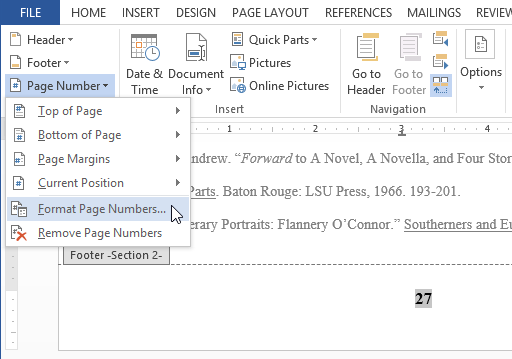 Formatting the page number
Formatting the page number
- A dialog box will appear. Click the Start at: push button. By default, it volition start at 1. If you want, you can change the number.
- Click OK.
 Restarting the page numbering
Restarting the page numbering - The page numbering volition restart.
 The restarted page numbering
The restarted page numbering
To larn more well-nigh adding department breaks to your document, visit our lesson on Breaks.
Challenge!
- Create a new Discussion document. If you want, you can apply our practice document.
- Create a bare header. If yous're using the case, unlock the header.
- Add a proper noun to the header. If you're using the example, blazon the name Tom Shelby later on Professor.
- Try inserting a preset header or footer.
- Add together today'due south date to the header. If yous're using the case, add today's date below Professor Tom Shelby.
- Try adding a folio number to the footer. If you're using the instance, add a folio number to the bottom of the page.
- Try restarting the page numbering.
/en/word2013/pictures-and-text-wrapping/content/
Source: https://edu.gcfglobal.org/en/word2013/headers-footers-and-page-numbers/1/
Posted by: yeearoult.blogspot.com

0 Response to "How To Put Last Name And Page Number On Word 2013"
Post a Comment